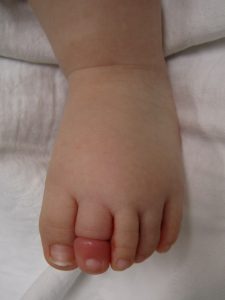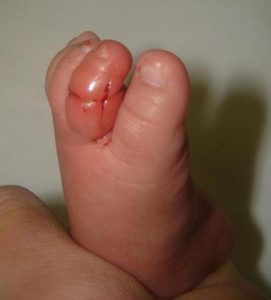

Photos before & after release from Wikimedia Commons
Hair tourniquets (and sometimes thread tourniquets) can occur on toes (most common), fingers, and more rarely the penis, clitoris, or uvula. Peak occurrence is at age 2-6 months, corresponding with maternal postpartum hair loss. Edema may progress to vascular compromise; ischemia and autoamputation have occurred. Tips for removal:
- Magnifying loupes can be helpful
- Consider topical anesthesia with EMLA or viscous lidocaine (avoid LET w/epinephrine so as to not confuse discoloration due to the tourniquet vs due to temporary epinephrine effect)
- If definitely a hair, depilatory cream (eg Nair) can be applied for 3-10 minutes on unbroken skin; repeat once if not successful (the product can irritate skin, however)
- AliEM describes use of a cutting needle to get under the hair and cut it https://www.aliem.com/2012/06/trick-of-trade-hair-tourniquet-release/
- If the hair is too deep / not visualized, the cutting needle can still be used to lift the tissue and constricting band, and a scalpel then used to cut the hair and superficial layer of tissue
- Severe tourniquets may require perpendicular cuts to the bone, best done at 3:00 and 9:00 positions
- Look for improvement in swelling and color with release. If the hair cut deeply, it may be difficult to see if release is complete. At least one author has studied ultrasound for identification https://www.ncbi.nlm.nih.gov/pubmed/29341258.
- Consult a urologist for deep penile tourniquets
- Consider child abuse, particularly with genitalia involvement
Leave a Reply